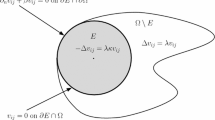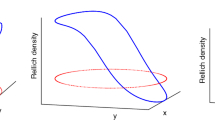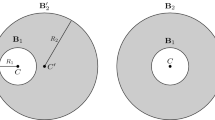Abstract
This article is concerned with a spectral optimization problem: in a smooth bounded domain \({\Omega }\), for a bounded function m and a nonnegative parameter \(\alpha \), consider the first eigenvalue \(\lambda _\alpha (m)\) of the operator \({\mathcal {L}}_m\) given by \({\mathcal {L}}_m(u)= -{\text {div}} \left( 1+\alpha m)\nabla u\right) -mu\). Assuming uniform pointwise and integral bounds on m, we investigate the issue of minimizing \(\lambda _\alpha (m)\) with respect to m. Such a problem is related to the so-called “two phase extremal eigenvalue problem” and arises naturally, for instance in population dynamics where it is related to the survival ability of a species in a domain. We prove that unless the domain is a ball, this problem has no “regular” solution. We then provide a careful analysis in the case of a ball by: (1) characterizing the solution among all radially symmetric resources distributions, with the help of a new method involving a homogenized version of the problem; (2) proving in a more general setting a stability result for the centered distribution of resources with the help of a monotonicity principle for second order shape derivatives which significantly simplifies the analysis.

Similar content being viewed by others
Notes
In other words
$$\begin{aligned} \lambda ^D({\Omega })=\inf _{u\in W^{1,2}_0( {\Omega })\,,\int _{{\Omega }}u^2=1}\int _{\Omega }|{\nabla }u|^2>0.\end{aligned}$$(18)Indeed, \(\{J_k,Y_k\}_{k\leqslant N}\) are uniformly bounded in \({\mathscr {C}}^2([r_0^*/R-{\varepsilon },R])\) for every \({\varepsilon }>0\) small enough. Since we consider a finite number of indices k, there exists \(\delta >0\) (depending only on N) such that
$$\begin{aligned} \forall k\in \{0, \dots ,N\}, \quad \det ({\mathcal {A}}_{k,\alpha })\geqslant \delta >0. \end{aligned}$$Then, since \(\Vert X_\alpha -X_0\Vert \leqslant M\alpha \), it follows from the Cramer formula that there exists M (depending only on N) such that \(\Vert X_{k,\alpha }-X_{k,0}\Vert _{L^\infty }\leqslant M\alpha . \)
References
Allaire, G.: Shape Optimization by the Homogenization Method. Springer, New York, 2002
Alvino, A., Lions, P.-L., Trombetti, G.: Comparison results for elliptic and parabolic equations via symmetrization: a new approach. Differ. Integr. Equ. 4(1), 25–50, 1991
Alvino, A., Trombetti, G.: A lower bound for the first eigenvalue of an elliptic operator. J. Math. Anal. Appl. 94(2), 328–337, 1983
Belgacem, F.: Elliptic Boundary Value Problems with Indefinite Weights, Variational Formulations of the Principal Eigenvalue, and Applications. Chapman & Hall/CRC Research Notes in Mathematics Series. Taylor & Francis, 1997
Belgacem, F., Cosner, C.: The effect of dispersal along environmental gradients on the dynamics of populations in heterogeneous environment. Can. Appl. Math. Q. 3, 379–397, 1995
Bressan, A., Coclite, G.M., Shen, W.: A multidimensional optimal-harvesting problem with measure-valued solutions. SIAM J. Control Optim. 51(2), 1186–1202, 2013
Bressan, A., Shen, W.: Measure-valued solutions for a differential game related to fish harvesting. SIAM J. Control Optim. 47(6), 3118–3137, 2008
Casado-Díaz, J.: Smoothness properties for the optimal mixture of two isotropic materials: the compliance and eigenvalue problems. SIAM J. Control Optim. 53, 2319–2349, 2015
Casado-Díaz, J.: Some smoothness results for the optimal design of a two-composite material which minimizes the energy. Cal. Var. Partial Differ. Equ. 53(3), 649–673, 2015
Casado-Díaz, J.: A characterization result for the existence of a two-phase material minimizing the first eigenvalue. Ann. l’Inst. Henri Poincare (C) Non Linear Anal. 34, 10, 2016
Caubet, F., Deheuvels, T., Privat, Y.: Optimal location of resources for biased movement of species: the 1D case. SIAM J. Appl. Math. 77(6), 1876–1903, 2017
Coclite, G.M., Garavello, M.: A time-dependent optimal harvesting problem with measure-valued solutions. SIAM J. Control Optim. 55(2), 913–935, 2017
Conca, C., Laurain, A., Mahadevan, R.: Minimization of the ground state for two phase conductors in low contrast regime. SIAM J. Appl. Math. 72, 1238–1259, 2012
Conca, C., Mahadevan, R., Sanz, L.: An extremal eigenvalue problem for a two-phase conductor in a ball. Appl. Math. Optim. 60(2), 173–184, 2009
Cox, S., Lipton, R.: Extremal eigenvalue problems for two-phase conductors. Arch. Ration. Mech. Anal. 136, 101–117, 1996
Dambrine, M., Kateb, D.: On the shape sensitivity of the first Dirichlet eigenvalue for two-phase problems. Appl. Math. Optim. 63(1), 45–74, 2010
Hamel, F., Nadirashvili, N., Russ, E.: Rearrangement inequalities and applications to isoperimetric problems for eigenvalues. Ann. Math. 174(2), 647–755, 2011
Hardy, G.H.: Note on a theorem of Hilbert. Math. Z. 6(3), 314–317, 1920
Henrot, A.: Extremum Problems for Eigenvalues of Elliptic Operators. Birkhäuser Basel, 2006
Henrot, A.: Shape Optimization and Spectral Theory. De Gruyter Open, 2017
Henrot, A., Pierre, M.: Shape Variation and Optimization, Volume 28 of EMS Tracts in Mathematics. European Mathematical Society (EMS), Zürich, 2018. A geometrical analysis, English version of the French publication [MR2512810] with additions and updates
Kao, C.-Y., Lou, Y., Yanagida, E.: Principal eigenvalue for an elliptic problem with indefinite weight on cylindrical domains. Math. Biosci. Eng. MBE 5(2), 315–35, 2008
Lamboley, J., Laurain, A., Nadin, G., Privat, Y.: Properties of optimizers of the principal eigenvalue with indefinite weight and Robin conditions. Calculus of Variations and Partial Differential Equations 55(6), 2016
Laurain, A.: Global minimizer of the ground state for two phase conductors in low contrast regime. ESAIM Control Optim. Cal. Var. 20(2), 362–388, 2014
Mazari, I.: Quantitative inequality for the eigenvalue of a Schrödinger operator in the ball. J. Differ. Equ. 269(11), 10181–10238, 2020
Mazari, I., Nadin, G., Privat, Y.: Optimal location of resources maximizing the total population size in logistic models. J. Math. Pures Appl. 134, 1–35, 2020
Mazari, I., Nadin, G., Privat, Y.: Optimisation of the total population size for logistic diffusive equations: bang-bang property and fragmentation rate. Preprint HAL, 2021
Mazari, I., Nadin, G., Privat, Y.: Some challenging optimisation problems for logistic diffusive equations and numerical issues (chapter). To appear in Handbook of Numerical Analysis, Volume 23, 2022
Mignot, F., Puel, J., Murat, F.: Variation d’un point de retournement par rapport au domaine. Commun. Partial Differ. Equ. 4(11), 1263–1297, 1979
Murat, F.: Contre-exemples pour divers problémes oú le contrôle intervient dans les coefficients. Ann. Mat. Pura Appl. 112(1), 49–68, 1977
Murat, F., Tartar, L.: Calculus of Variations and Homogenization, pp. 139–173. Birkhäuser Boston, Boston, 1997
Murray, J.D.: Mathematical Biology. Springer, Berlin, 1993
Oleinik, O., Shamaev, A., Yosifian, G.: Mathematical Problems in Elasticity and Homogenization, Volume 26 (Studies in Mathematics and its Applications). North Holland, 1992
Opic, B., Kufner, A.: Hardy-type Inequalities. Pitman Research Notes in Mathematics Series. Longman Scientific & Technical, 1990
Serrin, J.: A symmetry problem in potential theory. Arch. Ration. Mech. Anal. 43(4), 304–318, 1971
Author information
Authors and Affiliations
Corresponding author
Additional information
Communicated by G. Dal Maso.
Publisher's Note
Springer Nature remains neutral with regard to jurisdictional claims in published maps and institutional affiliations.
I. Mazari and Y. Privat were partiallly supported by the French ANR Project ANR-18-CE40-0013 - SHAPO on Shape Optimization. I Mazari was partially supported by the Austrian Science Fund (FWF) projects I4052-N32 and F65. I. Mazari, G. Nadin and Y. Privat were partially supported by the Project “Analysis and simulation of optimal shapes - application to lifesciences” of the Paris City Hall.
Proof of Lemma 1
Proof of Lemma 1
We prove hereafter that the mapping \(m\mapsto (u_{\alpha ,m}, \lambda _\alpha (m))\) is twice differentiable (and even \(\mathscr {C}^\infty \)) in the \(L^2\) sense, the proof of the differentiability in the weak \(W^{1,2}({\Omega })\) sense being similar. Let \(m^*\in \mathcal M_{m_0,\kappa }({\Omega })\), \(\sigma _\alpha {{:}{=}}1+\alpha m^*\), and \((u_0,\lambda _0)\) be the eigenpair associated with \(m^*\). Let \( h\in {\mathcal {T}}_{m^*}\) (see Definition 1). Let \(m^*_h{{:}{=}}m^*+h\) and \(\sigma _{m^*+h}{{:}{=}}1+\alpha (m^*+h).\) Let \((u_{h},\lambda _h)\) be the eigenpair associated with \(m^*_h\). Let us introduce the mapping G defined by
From the definition of the eigenvalue, one has \(G(0,u_{0},\lambda _{0})=0\). Moreover, G is \({\mathscr {C}}^\infty \) in \({\mathcal {T}}_{m^*}\cap B\times W^{1,2}_0({\Omega })\times \mathbb {R}\), where B is an open ball centered at 0. The differential of G at \((0,u_0,\lambda _0)\) reads
Let us show that this differential is invertible. We will show that, if \((z,k)\in W^{-1,2}({\Omega })\times \mathbb {R}\), then there exists a unique pair \((w,\mu )\) such that \(D_{v,\lambda }G(0,u_0,\lambda _0)[w,\mu ]=(z,k)\). According to the Fredholm alternative, one has necessarily \(\mu =-\langle z,u_0\rangle _{L^2({\Omega })}\) and for this choice of \(\mu \), there exists a solution \(w_1\) to the equation
Moreover, since \(\lambda _0\) is simple, any other solution is of the form \(w=w_1+tu_0\) with \(t\in \mathbb {R}\). From the equation \(2\int _{\Omega }u_0w=k\), we get \(t=k/2-\int _{\Omega }w_1u_0\). Hence, the pair \((w,\mu )\) is uniquely determined. According to the implicit function theorem, the mapping \(h\mapsto (u_h,\lambda _h)\) is \({\mathscr {C}}^\infty \) in a neighbourhood of \(\mathbf {0}\).
Rights and permissions
About this article
Cite this article
Mazari, I., Nadin, G. & Privat, Y. Shape Optimization of a Weighted Two-Phase Dirichlet Eigenvalue. Arch Rational Mech Anal 243, 95–137 (2022). https://doi.org/10.1007/s00205-021-01726-4
Received:
Accepted:
Published:
Issue Date:
DOI: https://doi.org/10.1007/s00205-021-01726-4




